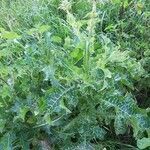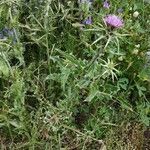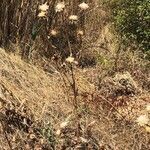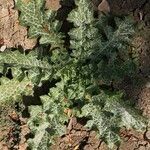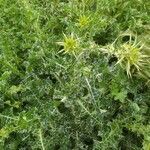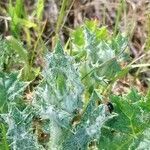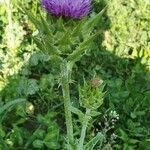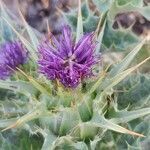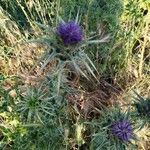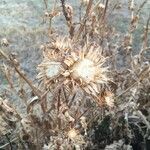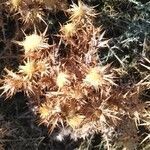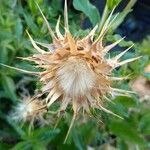Biennial herb 0.3–2 m high; stems ribbed, sparsely villous, emerging from a rosette of leaves.. Leaves pale green, mottled along the veins; rosette leaves obovate in outline, deeply triangular-lobed, 10–50 cm long, 5–25 cm wide, base petiolate, withered at time of flowering; cauline leaves only slightly lobed, ovate-lanceolate in outline, 2–20 cm long, 0.7–8 cm wide, base auriculate and amplexicaul; margins of all leaves strongly spiny-dentate, sparsely pilose.. Capitula terminal and solitary; involucre 2.5–4 cm long; phyllaries with an appressed ovate base, widening abruptly to an ovate appendage which recurves in the outer phyllaries, 1–4.5 cm long, with acuminate pungent apex; inner phyllaries without appendage.. Corolla blue-violet, tube filiform, 22–25 mm long, lobes 7–9 mm long, erect.. Achenes brown with black streaks, obovoid, 6–7 mm long, slightly compressed; pappus 15–22 mm long, connate into a basal ring and falling as a unit.. Fig. 13.
Herb to 2 m high. Stems glabrous or thinly pilose with arachnoid hairs. Leaves glabrous and mostly green above with a network of white areas, glabrous or sparsely white-tomentose below, with sessile glands absent; spines 2–6 mm long, white to pale yellow. Capitula solitary, terminal on 8–25 cm long side-branches; involucre globose, 25–45 mm diam. at anthesis excluding patent bracts; median involucral bracts patent, subulate, 20–45 mm long, 6–10 mm wide at widest point, with pectinate margins and rigidly spinose apex, glabrous dorsally. Corolla tube 20–28 mm long; lobes 5.5–7 mm long. Anthers 5.5–6 mm long. Achenes compressed oblong to ellipsoid, 5.6–6.7 mm long, brown with dark streaks. Pappus bristles distinctly flattened, 126–167, 15–20 mm long.
Annual or biennial herb, up to 2 m high; stems simple or sparingly branched, hollow, slightly cottony, leafy. Leaves oblong in outline, sinuate-lobate or pinnatifid, undulate, margins spiny; basal leaves narrowed to sessile. Capitula discoid, solitary, terminal; involucral bracts ovate-oblong, smooth at base, with long, triangular appendage, spine-tipped and spinose-ciliate at base. Receptacle flat, densely setose. Florets bisexual, fertile; corolla reddish purple; tube slender below, abruptly expanded above, deeply 5-lobed. Anthers with short tails; filaments connate into papillose tube. Style scarcely thickened below branches. Pappus of feathery bristles, soon caducous. Cypselae faintly transversely wrinkled.
Glabrous or slightly tomentose, 6–15 dm; lvs pinnately lobed, less so upwards, to 4 dm and nearly half as wide, petiolate below, becoming sessile and strongly auriculate-clasping above, spiny-margined, ± marked with white along the main veins; coarse, spreading tips of the invol bracts basally expanded; disk 3–6 cm wide; achenes 6–7 mm; 2n=34. A weed in waste places and about ballast-dumps; native of the Mediterranean region, rarely seen here and there in our range. May–July. (Mariana m.)
An annual herb. It is stout and erect. It grows 1-3 m tall. The leaves are shiny and green. They have a white mottle or marks on the upper surface. The lower leaves grow out from the main stem in a ring. The upper leaves clasp the stem. They are 10-50 cm long by 5-25 cm wide. They have rounded wings. The flower heads are reddish-purple. They are at the top of the plant. They have broad ridged bracts around them. These end in spines. The seedling leaves are free of spines.
Stems glabrous or slightly tomentose. Leaves: basal wing-petioled, blades 15–60+ cm, margins coarsely lobed; cauline leaves clasping, progressively smaller and less divided, bases spiny, coiled, auriculate. Phyllary appendages spreading, ovate, 1–4 cm including long-tapered spine tips. Corollas 26–35 mm; tubes 13–25 mm, throats campanulate, 2–3 mm, lobes 5–9 mm. Cypselae brown and black spotted, 6–8 mm; pappus scales 15–20 mm. 2n = 34.
Annual or biennial herb, up to 2 m high. Leaves oblong in outline, sinuate-lobate or pinnatifid, undulate, margins spiny, glabrous, marbled with white along veins above. Heads solitary, urceolate. Involucral bracts spine-tipped and spinose-ciliate at base, spreading or basal ones recurved. Flowers purple.
